mobile View, to the German Version tap the flag


- Republic of Cape Verde
- presidial republic
- own name: República de Cabo Verde
• Flag
• Historical Flags
• Meaning/Origin of the Flag
• Coat of Arms
• Meaning/Origin of the Coat of Arms
• Map
• Numbers and Facts
• History
• Origin of the Country's Name
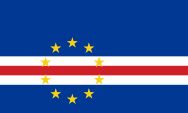
National flag,
ratio = 3:5,
Source, by: Drawn by User:SKopp [Public domain],
via Wikimedia Commons






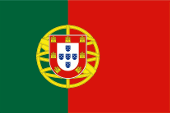
1911–1975,
National flag of Portugal,
ratio = 2:3,
Source, by:
Corel Draw 4





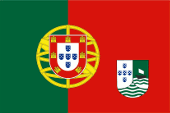
sixties of the 19th century,
purposed flag for Cape Verde,
ratio = 2:3,
Source, by:
Wikipedia (DE)



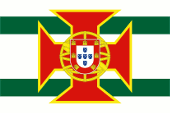
1935–1975,
Flag of the Governor General,
ratio = 2:3,
Source, by:
Die Welt im bunten Flaggenbild



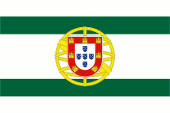
to 1935,
Flag of a High Commissioner,
ratio = 2:3,
Source, by:
Flaggenbuch 1939



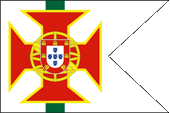
1935–1961,
Flag of a District Commandant,
ratio = 2:3,
Source, by:
Flaggenbuch 1939



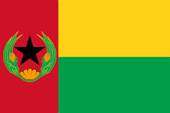
1975–1992,
National flag,
ratio = 2:3,
Source, by: Editor at Large, Waldir,
Public domain, via Wikimedia Commons






The today's flag of the Cape Verde Islands was introduced on 25th of September in 1992. It shows a single coloured dark blue bunting. The lower half of the flag is added by three narrow stripes in white, red und white. In the left half of the flag – medially above the white-red-white stripe – a circle of ten yellow stars. The blue stands for the Atlantic Ocean too, which surrounds the archipelago. The ten stars stand for the ten islands, the Cape Verde Islands consist in, and the red-white stripe represents the "Road of Progress". The introduction of the today's flag implys obviously for the Cape Verde Islands the farewell from the mutual socialistic ideals, which bond together the Cape Verde Islands with Guinea Bissau, just as the farewell from the ideas of the Pan-Africanism, because the Pan-African colours are not in use anymore. The new flag of the Cape Verde Islands has a European design. The colors of the flag are defined as follows: Blue = Pantone 287, Red = Pantone 186, Yellow = Pantone 116. The preceding green-yellow-red flag was hoisted for the first time on the 5th of July in 1975 – the independence day. It contained the Pan-African colours (red, yellow and green). It showed in the vertical red stripe near the pole an emblem (not the coat of arms) with a five-pointed black star, surrounded by a corn plants and a Jakob's Conch. The star symbolized the independence of the black African state. That flag was to differentiate from those of Guinea Bissau by their proportions (3:2 instead of 2:1) as well as by the corn plants and the Jakob's Conch. This flag of the Cape Verde Islands was based on the flag of the PAIGCV-party, which came into being in 1961. Its flag showed the black star of the African freedom (and was therewith obviously influenced by the flag of Ghana) and the initials of the party. The combination of the colours green, yellow and red are the pan-african colours: Perhaps in 1900 was the beginning of the Panafrica-Movement, wich wants to emphasize the commons of all people with black skin. For the political unity of Africa stands the colour-triad green-yellow-red, wich used many african countries in their flags after the independence. The first country was Ghana in 1957. As the origin apply the colours of Ethiopia (Abessinia), the oldest independent state in Africa. In the times of the Portugese colony was solely in use the Portugese national flag because they saw the colonies as permanent component of the motherland and not as outer possessions. This implys that Portugese colonies never had own flags, even if there were ambitions in the sixties of the 20th century to introduce flags for the colonies by placing of the coat of arms of the colony in the flying end of the Portugese national flag. But this plans became never realized.
Source:
National flagn der Welt,
Flaggen Wappen Hymnen,
Die Welt der Flaggen,
Volker Preuß,
Wikipedia (EN)

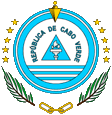
since 1992,
Coat of arms of Cape Verde,
Source, by:
Wikipedia (D)
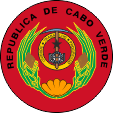
1974–1992,
Coat of arms of Cape Verde,
Source, by:
Corel Draw 4

1935–1975,
Coat of arms of Cape Verde,
Source, by:
Wikipedia (D)

The coat of arms of the Cape Verde Islands, which was adoped on the 5th of July in 1975 on the occasion of the independence, showed a red disk, on it, to the left and on the right, per one corn plant, below a Jakob's Conch. In the middle a golden circle with an hoe, a cogwheel, an opened book and the Black Star, the lodestar of the African freedom. The corn stood for the most important agrarian product of the country, and should emphasize the importance of the agriculture. The Jakob's Conch stood for the meaning of the ocean for the islands, but had even an christian background. The hoe stood for the farmers, the cogwheel for the workers and the book for the intellectuals. In the golden circle the then motto of the country in Portugese language: "Unidade, Trabalho, Progresso" → "Unity, Work, Progress". With the gradual democratization was on the 25th of September in 1992 adoped – in addition to a new flag for the country – as well a new coat of arms. It shows a pale blue circle, in the lower part added by three pale blue horizontal stripes. In the middle of the circle a isosceles pale blue triangle (symbol of equality) with a silvery torch (symbol of freedom), surrounded by the name of the state in Portugese language. Quite above a lead weight (symbol of the justice), to the left and on the right in total ten golden stars (the single islands of the Cape Verde Islands), and below two palm fronds (sign of victory) and three chain links (symbols of cohesiveness). In the year 1935 own coats of arms were created for the Portuguese colonies. The design was subject to a special scheme. So each coat of arms contained, in addition to a local symbolism, the five Quinas from the coat of arms of Portugal and five green waves on silver. As the local symbolism in the coat of arms of Cape Verde appeared a caravel.
Source:
Nationalflaggen der Welt,
Flaggen Wappen Hymnen,
Die Welt der Flaggen,
Volker Preuß

Location:
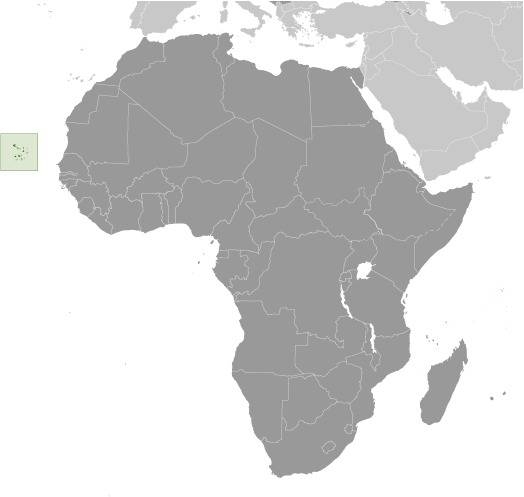
Source: CIA World Factbook
Map of the country:
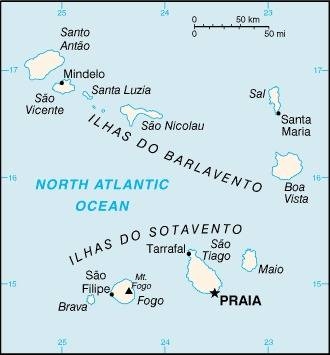
Source: CIA World Factbook

Area: 1.557 square miles
Inhabitants: 483.628 (2021), thereof 71% Creole (Mulatto), 28% Africans, 1% Europeans (mostly Portugese)
Religions: 77% Roman Catholic, 5% Protestant, 2% Muslim, 11% Non-Religious
Density of Population: 311 inh./sq.mi.
Capital: Praia, 127.524 inh. (2009)
official Language: Portugese
other Languages: Creole Portugese
Currency: 1 Cape Verde Escudo (CVE, CVEsc) = 100 Centavos
Time Zone: GMT – 1 h
Source:
Wikipedia (D),
CIA World Factbook

1445 · discovery by the Portugese Diego Gomes
1460 · settlement of the islands
1495 · the Cape Verde Islands become Portugese colony
1585 · the English pirate Francis Drake plunders the harbor Ribeira Grande
1592 · the English pirate Francis Drake plunders the harbor Ribeira Grande again
1876 · interdiction of the slave trading
1951 · the island get the status of a Portugese overseas province
1961 · foundation of the PAIGCV-party, beginning of the struggle for the independence of the Cape Verde Islands and Guinea Bissau
10th of September 1974 · Guinea Bissau becomes independent
5th of July 1975 · Portugal grants Cape Verde independence
1981 · new constitution, irrevocable separation from Guinea Bissau
1990 · introduction of the multi-parties-system
Source:
Atlas zur Geschichte,
Discovery '97,
Weltgeschichte,
Wikipedia (D)

The name of the country derives from Cap Vert ( "Green Cape "), which is the westernmost headland of the African continent. The archipelago of the Cape Verde itself is once again about 600 km west in the Atlantic Ocean.
Source:
Volker Preuß


![]()





















